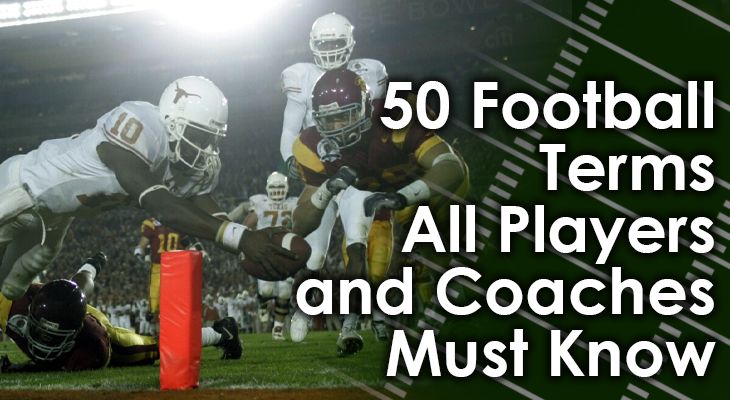If you're going to teach the game to youth and high school players, you'll need to know what all the many football terms mean.
At the same time, it's equally important for players to understand football lingo.
Here are 50 football terms all players and coaches must know:
Football Terms List:
1. Audible
When quarterbacks (QB) approach the line of scrimmage, they may call an audible.
This is when QBs change the original play called just before the snap.
QBs do this when they believe the original play would not work out too well based on the defensive formation.
2. Blitz
A blitz is a defensive play call where the defense tries to have more players rush the passer than the offense can block.
It usually involves a linebacker, cornerback and / or safety rush the quarterback in addition to the defensive linemen.
3. Box
The "Box" refers to the defensive area between both offensive tackles.
It also extends roughly seven yards off the line of scrimmage.
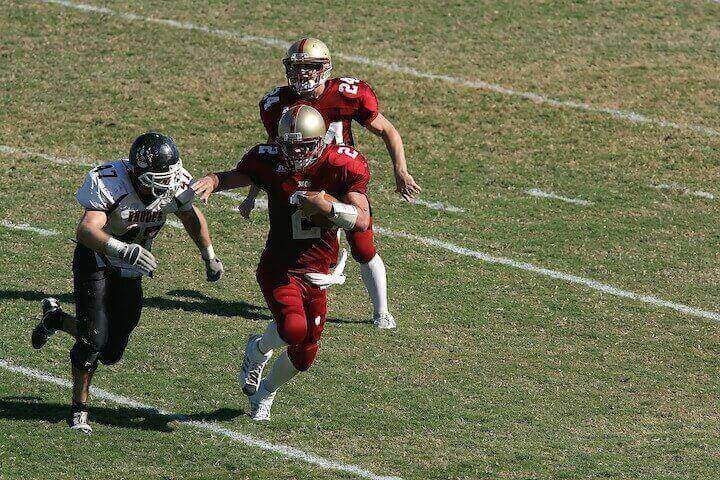
4. Cadence
Watching a football game, you'll probably hear QBs shout some combination words right before the start of the play.
The words they shout out are usually a combination of colors, cities, and numbers -- like "Green-88!" for example.
This is called "cadence," and it's the language quarterbacks use before they call for the snap of the ball.
5. Chip Block
A running back or tight end will run the chip block.
Right after the snap, he'll "chip" on a defender to knock them off balance, before releasing a running a passing route.
6. Corner Route
This is a passing route that involves a receiver running upfield, then bending the route toward a sideline.
7. Cover 0
The Cover 0 is a type of defensive coverage scheme that involves having no deep defenders.
It's man-to-man coverage that typically features a heavy blitz from defenders.
8. Cover 1
The Cover 1 is also a man-to-man defensive scheme, but this time the with one safety that acts as a safety valve over the top.
The safety will play zone coverage, while every other defender will play man-to-man.
9. Cover 2
The Cover 2 is another hybrid defensive scheme mix.
Here, two (2) safeties (strong and free) will both play zone coverage deep, splitting the field in half.
The other five defenders underneath (linebackers and cornerbacks) will play man-to-man.
10. Cover 3
The Cover 3 is a purely zone defensive coverage.
Three defensive backs will split the field in thirds deep, while the four underneath defenders will split the field into quarters.
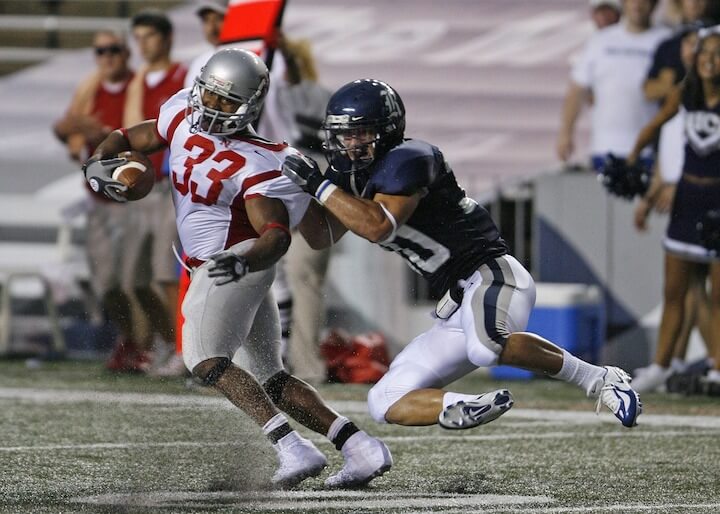
11. Cover 4
Also known as quarters coverage, this zone coverage involves all four defensive backs.
The two cornerbacks are responsible for the outside deep zones, and the safeties will cover the middle deep zones.
12. Crackback Block
The crackback block is a football term for a type of "surprise" block.
A wide receiver will line up out wide, then will motion closer toward the formation.
After the snap, they'll deliver a blindside block to a defender on the edge, allowing the play to move outside of him.
13. Dig Route
The Dig Route is a passing route that starts with a receiver sprinting straight ahead.
After about 15 yards, they will cut back at a 90-degree angle to receive the catch.
14. Double Move
This describes a passing route that combines two (2) basic routes.
The first half of the Double Move will be a basic route, while the second half will be another route (like the Sluggo Route).
15. Draw
The Draw play is a disguised offensive play, meant to make the defensive think it's a pass, only to end up as a run.
QBs will start by dropping back into what looks like a pass, before pulling the ball down and handing it off to a running back at the last second.
16. End Around
This is sometimes also referred to as a jet sweep.
It's a rushing play that designed for the wide receiver.
Here, they'll come around from an outside position to take a pitch or handoff from the quarterback in the backfield.
17. Extra Point
After a scoring a touchdown, the team can attempt an Extra Point.
It's a place kick that looks like a field goal, but attempted closer in.
A successful Extra Point will result in the team getting one (1) point.
18. Fair Catch
This is a tactic used by a punt or kick returner to receive the kick freely without getting tackled.
When they signal for a Fair Catch, they won't be able to advance the kick once catching it.
19. False Start
The False Start is one of the most common offensive penalties called in football.
It involves any offensive player moving before the snap of the ball.
20. Field Goal
This is one of the most basic scoring plays in a football game.
A place kicker will kick the ball through the uprights in the end zone.
Successful Field Goal attempts result in the offense scoring 3 points.
21. Fire
One of the lesser known football terms...
The holder on place kicks (extra points or field goals) will call "Fire" if the snap or hold is off.
They will then get up out of the crouched position and try to run with the ball or throw a pass.
The "fire" call signifies that the offensive line needs to block and receivers need to go out on a route.
22. Gaps
Gaps are the spaces between two offensive linemen.
These help identify where running backs should run and where defenders need to cover.
23. Go Route
This is a pass route where the receiver will run straight down the field in a deep route.
24. Holding
Holding is one of the most common penalties called in football.
It happens when either an offensive or defensive player grabs a hold of an opponent's jersey or body part.
Offensive holding results in a loss of 10 yards. Defensive holding, on the other hand, leads to a 5-yard gain and an automatic first down for the offense.
25. I-Formation
The I-Formation is one of the basic offensive formations and still used a lot in youth football.
It typically involves one (1) tight end, two (2) wide receivers, one (1) full back and one (1) running back.
Here, the fullback and running back line up directly behind the quarterback in a line.
26. Jam
This football term describes a move a defender will make right after the snap.
At the snap, the defender will "jam" the receiver right at the line of scrimmage, disrupting their path and the timing with the quarterback.
27. Kickoff
A kickoff happens at the start of every game, the start of the second half as well as following every score.
It's a place kick that starts at the team's own 35-yard line. The ball must travel at least 10 yards before the kicking team is able to touch the ball.
28. Line of Scrimmage
This is an imaginary line that runs perpendicular to where the nose of the football is placed by the official.
The line of scrimmage runs from one sideline to the next.
It determines where the play starts, and where the offensive players and defensive players must line up.
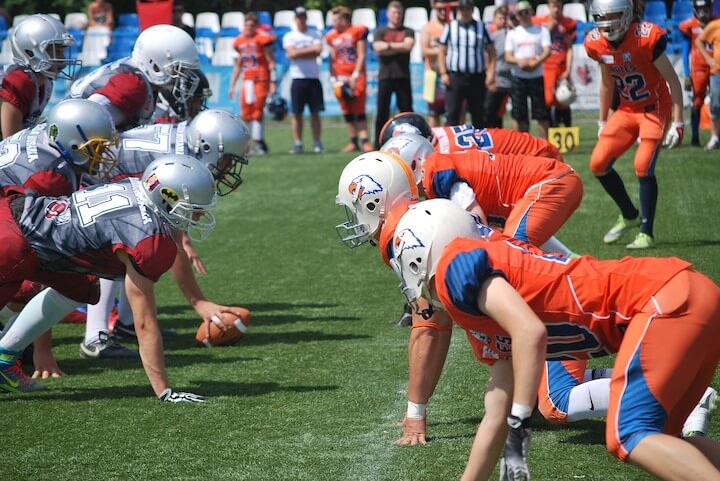
29. Nickel
This is a defensive formation that involves subbing out a linebacker from the base defense in favor of an extra cornerback.
It's called Nickel because it involves having 5 members of the secondary on the field.
30. Onside Kick
An onside kick is an attempt by the kicking team to recover the football and get the ball back for the offense.
They will kick the ball just 10 yards, and attempt to have their players take possession of the ball before the opponents do.
31. Pass Interference
The Pass Interference is a penalty that is typically committed by defenders, but sometimes receivers, too.
This happens when a defender makes contact with a receiver while the ball is in the air, preventing them from getting a fair chance at catching a pass.
32. Protection
This football term refers to the blocking scheme called to prevent defenders from getting to the quarterback on passing plays.
33. Play Action
Play action is a type of offensive play call that's meant to disguise a pass play as a run, to throw the defense off.
The quarterback will first fake a handoff before pulling the ball down and throwing a pass.
34. Punt
This happens most of the time when the offense faces a "fourth and long" situation and is too far away to attempt a field goal.
Meaning, the offense gets to fourth down but would have trouble scoring or converting to a first down on the next play -- "4th and 10", for example.
The punter will then kick the ball away to the other team.

35. Quarter
The length of a game of football is divided into four quarters -- quarters 1 and 2 are the first half, while quarters 3 and 4 are the second half.
How long the quarters last depends on the level of football (i.e., youth, high school, college, NFL).
36. Scramble
This is what happens when the quarterback drops back to pass but doesn't find an open receiver.
They will then pull the ball down and try to run it, which is sometimes called a Scramble.
37. Screen Pass
The Screen Pass is a pass play that starts looking like a deep drop back, but then ends as a short pass, often behind the line of scrimmage.
The blockers will start by snapping into pass blocking. They will then "release" and serve as lead blockers when the receiver catches and runs downfield.
38. Seam Route
The Seam Route is a passing route run toward the middle of the field. The receiver will run a deep route along the field's hashmarks, known as the 'Seam'.
39. Secondary
In football, the secondary refers to all the defensive backs that are on the field at one time. It includes any cornerbacks and safeties that are on the field.
40. Shotgun
This describes how the quarterback lines up before the snap.
In Shotgun, QBs will line up about 5 yards behind the center, rather than directly behind them. The center will then snap the ball back to the QB.
The Shotgun formation gives more space (and time) for the quarterback to react to defenses and pass rushers.
41. Spin Move
This is a maneuver a defender will take to try to evade a blocker.
Here, they will go in one direction, pivot on one foot, and then spin to the other side -- hopefully leaving the blocker in the dust.
42. Spread Formation
This is an offensive formation that more and more teams are using nowadays.
It typically involves only five offensive linemen, multiple wide receivers and only one running back. The quarterback will often line up in Shotgun for this formation.
43. Swim Move
This is another maneuver defenders will take to evade blockers.
They'll deliver a straight blow to the blocker's shoulder, and then swing his other arm up and over the blocker's body to get by them.
It's called a Swim Move because it looks a lot like a freestyle swim stroke.
44. Touchdown
This is the ultimate goal of the offense on every drive -- to score a Touchdown.
This happens when a player crosses the opponent's goal line with the ball in their hands.
When either the offense or defense does this, it results in their team scoring six (6) points.
45. Trips
This refers to an offensive formation in which three (3) wide receivers line up in a bunch on one side of the football.
Most of the time, the receivers will line up in a triangle shape, with one (1) receiver on the line of scrimmage and the other two (2) off the line.
46. Two-Point Conversion
After scoring a touchdown, the team may opt to go for a Two-Point Conversion instead of an extra point attempt.
This will be a normal but untimed offensive play run from the 2-yard line.
If the offense is able to get the ball across the goal line, they score an additional two (2) points.
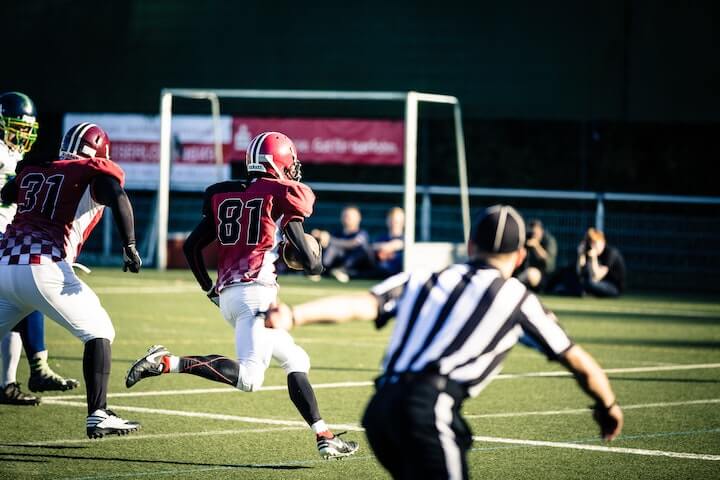
47. Wheel Route
The wheel route is a passing route that involves two (2) players.
The inside receiver will cross paths with the outside receiver after running roughly five (5) yards.
The inside receiver will break toward the outside of the field, and then run straight down the sideline.
48. Zone Blocking
This is a blocking scheme that has become very popular in football today.
It involves the offensive linemen blocking gaps rather than a particular defender.
It involves a lot of double-team blocking, and is quite easy for players to understand.
49. '3-4'
This is a base defensive formation.
It involves having three (3) down defensive linemen, four (4) linebackers and four (4) members of the secondary.
50. '4-3'
This is another base defensive formation.
It involves having four (4) down defensive linemen, three (3) linebackers and four (4) members of the secondary.

